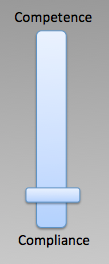![]()

In this series of posts, I explore six ways in which learning professionals can realise a transformation in the way that learning and development occurs in their organisations. It builds on the series I posted earlier in the year, in which I set out the six major elements in a vision for change, i.e. learning that is aligned, economical, scalable, flexible, engaging and powerful.
The third step on the route to transformation is a shift from interventions aimed primarily at ensuring compliance to those that aim to achieve competency. Now every organisation does, to some extent, have to comply with regulations of one sort or another, whether that relates to employment policies, health and safety, the prevention of money laundering, the marketing of pharmaceutical products, and so on. The implications of breaking these regulations – and being found out – can be devastating for an organisation, not only financially, but in terms of public reputation. In extreme cases, executives and others lower down in an organisation could face criminal charges. Not surprising, then, that organisations – sometimes on the insistence of their insurers – take great pains to ensure that infringements are kept to a minimum. An obvious step in achieving this is to ensure everyone involved obtains adequate training.
There are two ways of looking at this sort of training: (1) you can regard it as a simple box-ticking exercise in which employers and employees go through the motions of delivering and receiving training, in order to satisfy regulators and insurers that the job is being done; or (2), you aim to bring about a shift in behaviour such that infringements are very unlikely to occur, because employees believe in the policy and have the necessary knowledge and skill to put it into practice. Option (1) is based on the assumptions that infringements are unlikely, the regulations are a nuisance and that compliance is a necessary evil. Option (2) is founded on the principles that infringements can and do happen, that the regulations are rightly in place to prevent harm to third parties, and that policies are not enough – delivering on these policies requires competence. Quite a difference.
The implications of an approach based on compliance
So what are the dangers of basing your approach to training on simple compliance?
- Executives and learning professionals regard the whole exercise as a box-ticking exercise.
- The training is designed to deliver as much dry and abstract information as possible in the minimum time. Subject-matter experts rather than learning professionals drive the design.
- Knowledge is typically assessed immediately after delivery of the information, invalidating the results. No effort is made to assess whether this information can be applied effectively in context, in other words competence.
- Employees will do the minimum possible to complete the training, focusing all their attention on passing the assessment rather than on gaining useful information that is important for their job.
- On the basis that people resist ‘being changed’, it is possible that the whole process makes them less likely to comply rather than more so.
- E-learning is often used as the means of delivery to minimise costs and take the pressure off trainers who understandably don’t want to deliver training that nobody wants to do. As a result, e-learning becomes synonymous with compliance and bad training generally.
Shifting the emphasis to competence
How would the picture change if a genuine attempt was made to ensure competence?
- Executives and learning professionals would themselves be committed to change and would model the desired behaviour consistently.
- The training would focus on encouraging positive attitudes to the necessary change, providing critically-important information (the rest can be accessed as reference resources), putting principles into context with examples and case studies and, most importantly, providing plenty of opportunities for practice (with supportive feedback).
- Employees are assessed on the basis of their ability to apply what they have learned in context rather than their ability to retain information.
- Management reinforce the desired behaviour when it is put into practice.
- E-learning is used when it is an appropriate medium for delivering elements of what is likely to be a blended solution.
The benefits
So what effect does pushing the slider from compliance to competence have on the six elements of our transformation vision?
Aligned: Courses oriented to building competence can be directly aligned to business needs. This means genuinely complying with the requirements of regulators, not just going through the motions of delivering compliance training.
Economical: Sorry, but competence-based training will cost more to deliver. On the other hand have you factored in the real risk of a billion dollar lawsuit?
Scalable: Again, quality comes at a cost. Simple self-study courses may be cheaper, but are they really achieving a positive return?
Flexible: To be honest there’s not going to be a lot of change here. If anything, more elaborate blends are going to be less easy to complete than those that concentrate on ticking the boxes. So, no more asking your assistant to click through the screens on your behalf.
Engaging: Relevance drives out resistance. Who’s going to be engaged by a box-ticking exercise?
Powerful: And here’s the bottom line. Competency-based training really will protect you from risk and surely that’s the whole point.
Coming next: Strategies for transformation 4: from top-down to bottom-up
Looking back: 1. From generic to tailored 2. From synchronous to asynchronous





